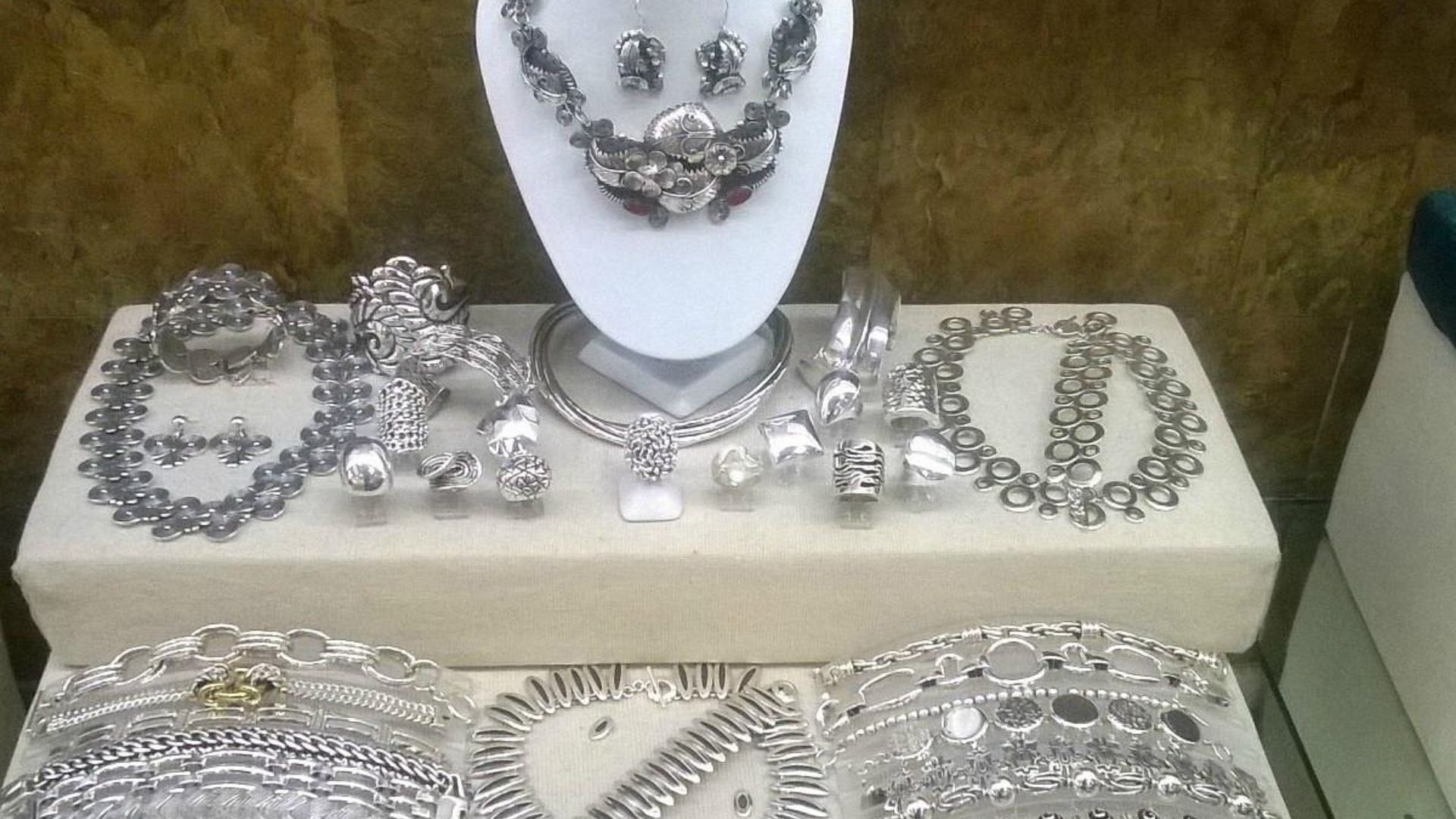Mexico has a long-standing tradition of producing exquisite silverjewelry. The craftsmanship and artistry displayed in Mexican silver jewelryreflect the country's rich cultural heritage and have gained international acclaim.
From intricate designs to unique techniques, Mexican silver jewelry captures the essence of Mexican culture and offers a diverse range of styles for jewelry enthusiasts. Let's delve into the world of Mexican silver jewelry and discover the beauty and significance it holds.
Mexican silver jewelry is a testament to the rich cultural heritage of Mexico. Each piece tells a story, preserving traditions and celebrating the country's diverse history. From the intricate details to the symbolism embedded in the designs, Mexican silver jewelry encapsulates the essence of Mexican culture.
One of the defining features of Mexican silver jewelry is its incorporation of indigenous influences. The vibrant colors, intricate patterns, and symbolic motifs found in traditional indigenous art are seamlessly woven into silver jewelry designs.
From the intricate feather motifs inspired by the Aztec civilization to the animal motifs representing spiritual connections, these elements pay homage to Mexico's indigenous roots.
History And Legacy Of Mexican Silver Jewelry
Mexican silver jewelry has a storied history that dates back centuries. The art of silversmithing was introduced to Mexico by Spanish colonizers in the 16th century.
Over time, Mexican artisans adapted and infused their own artistic influences, resulting in a distinctive style that blends indigenous traditions with European techniques. The city of Taxco, nestled in the mountains of Guerrero, is renowned as the hub of Mexican silver jewelry production and craftsmanship.
The arrival of the Spanish in the 16th century marked a significant turning point in the history of Mexican silver jewelry.
With the conquest of Mexico, the Spanish introduced European metalworking techniques and styles, merging them with indigenous craftsmanship. This fusion resulted in the birth of a unique and distinct Mexican silver jewelry tradition.
During the colonial era, silver mining became a prominent industry in Mexico. The discovery of rich silver deposits, particularly in regions like Taxco, Zacatecas, and Guanajuato, led to the rapid growth of silver production.
Skilled artisans and craftsmen emerged, honing their skills and creating exquisite silver jewelry pieces that showcased a harmonious blend of Spanish and indigenous influences.
Mexican silver jewelry is known for its symbolic representations and cultural significance. Many designs incorporate symbols and motifs that hold deep meaning in Mexican culture.
For instance, the iconic image of the eagle and the serpent from the Mexican flag, known as the "Mexican Coat of Arms," is often seen in silver jewelry, representing the country's national identity and heritage.
Traditional Techniques In Mexican Silver Jewelry
Traditional techniques play a vital role in the creation of Mexican silver jewelry, adding a distinct charm and authenticity to each piece.
Passed down through generations, these time-honored techniques showcase the skill and craftsmanship of Mexican artisans.
From intricate filigree work to vibrant enamel accents, these techniques contribute to the unique beauty and cultural significance of Mexican silver jewelry.
- Delicate Artistry(Filigree)- Filigree is a prominent technique in Mexican silver jewelry, characterized by the use of fine silver wires that are twisted, curled, and soldered together to create intricate patterns and designs. This delicate art form requires precision and patience, as each wire must be carefully shaped and secured.
- Raised Designs(Repoussé) - The repoussé technique involves creating raised designs on silver by hammering and shaping the metal from the reverse side. Skilled artisans use specialized tools to meticulously push and mold the silver, resulting in intricate patterns and textures.
- Artistic Detailing(Engraving) - Engraving is a versatile technique employed in Mexican silver jewelry to add intricate details and personalization. Artisans use fine tools to etch designs onto the silver surface, creating patterns, symbols, and text.
- Colorful Accents(Inlay) - Inlay is a technique that involves setting gemstones, shells, or other materials into silver to create colorful accents and patterns. Artisans carefully cut and shape the stones to fit precisely into the silver setting, creating a seamless and eye-catching effect.
- Antique Finish(Oxidation)- Oxidation, also known as antiquing, is a technique used to darken the silver surface, giving it an aged or vintageappearance. Artisans apply a patina or chemical solution to the silver, which reacts with the metal and creates a black or grayish layer.
Symbolism And Cultural Significance
Symbolism and cultural significance play a significant role in Mexican silver jewelry, making each piece a testament to the rich traditions and beliefs of Mexican culture.
The use of symbols and motifs in the design of these jewelry pieces carries a deep meaning and reflects the cultural heritage of the region. Let's explore some of the prominent symbols and their cultural significance in Mexican silver jewelry.
- Devotion and Love(Sacred Heart)- The Sacred Heart, or Corazón Sagrado, is a prominent symbol in Mexican culture and holds deep religious significance. Depicting the heart of Jesus Christ, it represents divine love, compassion, and devotion.
- Celebration of Life and Death(Calavera)- The Calavera, or skull, is a symbol associated with the Day of the Dead, a significant Mexican holiday honoring deceased loved ones. It represents the cycle of life and death, reminding people to celebrate and remember their ancestors.
- Feathered Serpent Deity(Quetzalcoatl) - Quetzalcoatl, the feathered serpent deity, holds great importance in Aztec and Mexican mythology. Representing wisdom, fertility, and the forces of nature, the Quetzalcoatl symbol is frequently seen in Mexican silver jewelry.
- Resilience and Strength(Nopal) - The nopal, or prickly pear cactus, is a symbol of resilience and strength in Mexican culture. It represents the ability to thrive and flourish even in harsh conditions. The nopal symbol is often featured in Mexican silver jewelry, symbolizing endurance, protection, and the ability to overcome challenges.
- Cosmic Connection(Aztec Calendar) - The Aztec calendar, also known as the Sun Stone, is a circular stone disc adorned with intricate carvings that represent Aztec cosmology and their understanding of time.

Taxco silver: William Spratling, Carmen Tapia, Cristina Romo, NEIGHBORS episode
Regional Styles In Mexican Silver Jewelry
Mexican silver jewelry encompasses a wide range of regional styles, each with its own distinct characteristics and influences.
These regional styles showcase the diversity and creativity of Mexican artisans, making Mexican silver jewelry highly sought after by collectors and jewelry enthusiasts worldwide. Let's explore some of the notable regional styles in Mexican silver jewelry.
Taxco Silver - Epitome Of Mexican Craftsmanship
Taxco, a small town in the state of Guerrero, is renowned for its silver mines and skilled artisans. Taxco silver jewelry is synonymous with exceptional craftsmanship, intricate designs, and high-quality materials.
Oaxacan Filigree - Delicate Elegance
Oaxaca, a state in southern Mexico, is known for its exquisite filigree work in silver jewelry. Filigree involves twisting and curling thin silver wires into intricate patterns to create delicate and ornate designs.
Huichol Beadwork - Vibrant And Spiritual
The Huichol people, an indigenous group in Mexico, are known for their intricate beadwork, which is often incorporated into silver jewelry.
Huichol beadwork involves meticulously placing small, colorful beads onto a wax-coated surface to create vibrant and intricate designs. These beads are then fused with silver to form eye-catching jewelry pieces.
Yucatan's Mayan Influence - Mystical And Symbolic
The Yucatan Peninsula in Mexico is home to the ancient Mayan civilization, and its influence can be seen in the silver jewelry produced in the region.
Mayan-inspired silver jewelry often features symbols and motifs from Mayan mythology and cosmology. These include depictions of deities, glyphs, animal totems, and celestial elements.
Jalisco's Charro Tradition - Equestrian Elegance
Jalisco, a state in western Mexico, is known for its vibrant charro culture, which celebrates horsemanship and traditional Mexican cowboy attire. Charro-inspired silver jewelry often incorporates equestrian motifs such as horseshoes, spurs, lassos, and horse heads.
People Also Ask
What Is The Significance Of The Eagle Mark On Mexican Silver Jewelry?
The eagle mark, also known as the "hallmark," is a symbol used to authenticate the quality and authenticity of Mexican silver jewelry.
Are Gemstones Commonly Used In Mexican Silver Jewelry?
Yes, gemstones are often incorporated into Mexican silver jewelry to add color, and vibrancy, and enhance the overall design.
What Is The Significance Of The Day Of The Dead In Mexican Silver Jewelry?
The Day of the Dead, or "Dia de los Muertos," is an important cultural celebration in Mexico. It is often represented in Mexican silver jewelry through skull motifs and symbols of life and death, reflecting the belief in honoring and remembering loved ones who have passed away.
How Do Mexican Artisans Create Unique Textures In Silver Jewelry?
Mexican artisans use various techniques to create texture in silver jewelry, such as hammering, stamping, and oxidizing.
Is Mexican Silver Jewelry Considered A Good Investment?
Mexican silver jewelry is highly regarded for its craftsmanship, cultural significance, and enduring beauty. As a result, it can be a valuable investment, particularly if it is created by renowned artisans or from reputable silver workshops.
Conclusion
Mexican silver jewelry is a testament to the rich cultural heritage of Mexico. Its history, traditional techniques, symbolism, and regional styles showcase the artistic prowess and craftsmanship of Mexican artisans.
The combination of silver with vibrant gemstones, intricate textures, and unique designs makes Mexican silver jewelry truly remarkable.
Whether it's the iconic eagle mark, the influence of the Day of the Dead, or the use of regional motifs, Mexican silver jewelry carries with it a sense of authenticity and cultural significance.
With its enduring beauty and value, Mexican silver jewelry continues to captivate and inspire jewelry enthusiasts around the world, making it a cherished and meaningful adornment.
